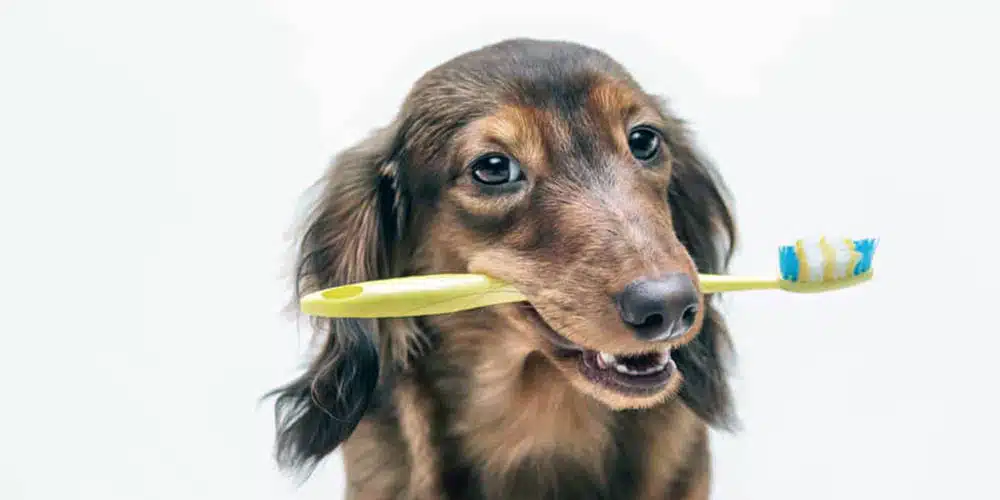
Dachshund Care: Keeping Your Pup Happy and Healthy
Did Dr. Google tell you that Dachshund pups can be a bit challenging? Well, here’s the truth. They are, but there’s no need to panic. There is a reason why you can find Dachshunds on the list of best dog breeds to adopt. Yes, they are a bit hardheaded, and yes, it’s not an easy task to train them. Still, there is a big but here. Taking care of Dachshund fluffs is a rewarding task as they are the most loving pups you’ll ever befriend.
If you want to provide your pup with the best care possible, you’re at the right place. We’ll give you all the information you need and walk you through every step of the way so that both you and your buddy enjoy the experience.
Nurturing Dachshund pups requires familiarity with their history and personality. Once you cover all that, you may start dealing with the main part—Dachshund care. So, let’s dig into what you need to know.
Best Supplements for Dachshund
For Dachshunds, focus on joint health with supplements containing glucosamine and chondroitin to address their susceptibility to spine and joint issues. Omega-3 fatty acids, often from fish oil, support skin health and are vital for Dachshunds with sensitivities. A balanced multivitamin fills nutritional gaps, and probiotics aid in maintaining a healthy digestive system, which is crucial for their sometimes sensitive stomachs. Weight management supplements can be considered to address the breed’s predisposition to obesity.

- Joint health support for dogs: cosequin, the #1 veterinarian recommended retail joint health supplem
- Omega-3 fatty acids: each soft chew also contains omega-3 fatty acids to help support skin and coat
- Manufactured in the united states with globally sourced ingredients: cosequin is a high-quality, dog
- From the #1 veterinarian recommended supplement company*: nutramax laboratories veterinary sciences
- Backed by science: nutramax laboratories veterinary sciences supplements are veterinarian formulated

- This natural fish oil additive supplement works to support your pal’s skin, coat, hips and joints, heart and immune system.
- The premium salmon oil is rich with omega-3 and -6 fatty acids from EPA and DHA to promote soft skin, a shiny coat and good overall health.
- May also help support proper hip, joint, heart and immune function.
- Makes a yummy alternative to capsules or soft chew supplements—simply add to your pet’s favorite meal.
- Great for small, medium and large breed dogs or cats.

- Your sidekick deserves a shiny coat and healthy skin she can feel proud of and show off.
- A therapeutic blend of organic horsetail, dandelion, spirulina and bladderwrack help maintain hair shafts and follicles to promote healthy skin and hair.
- Give your gorgeous girl the capsule whole or mix it into her food.
- PetAlive supplements are made from lab-tested, raw ingredients with no added fillers, gluten, artificial colors, flavors or preservatives.
- Made in FDA-registered, cGMP (current Good Manufacturing Practice) compliant facilities.
History and Personality of a Dachshund
Source: thedoxieworld
Dachshund cuties, also known as wiener or sausage dogs, come from Germany, where they were bred five centuries ago. Their name in the literal translation means a badger dog. Their task was to hunt badgers and other pests who made farmers’ lives miserable. Hence, they have an instinctive habit of attacking whatever comes their way. Don’t be surprised to see them gang up on much larger animals. They most certainly believe they’re elephants or lions at times.
The One Thing Pet Owners Regret Not Doing Until It’s Too Late
Is your pet safe?
1 in 3 pets will need emergency veterinary treatment each year and it is estimated a pet receives emergency care every 2.5 seconds in the U.S.
The average cost of treating a broken bone in dogs is $2,700. Cancer treatments? Up to $10,000.
It’s why so many pet owners say their biggest regret isn’t the vet bill—it’s not having pet insurance when they needed it most.
Ask yourself: “If an unexpected $5,000 vet bill hit tomorrow, could I afford it?”
If the answer is no, it’s time to get covered.
Take a look at Lemonade. They have a great app that actually works, they have an instant chatbot that is faster and, dare we say it, friendlier than most companies’ “real” customer service and a quick scroll through Reddit will uncover… people are really vibing with this brand.
So go check them out and take a look. It takes less than a minute.
Barking is how they warn of danger, and they seem to find it everywhere! Their favorite hobbies are digging and chewing, to which they resort when they feel bored or alone. Your hairy friend will not seek your attention only when you’re asleep (if you’re lucky).
These cuties are known for their temperamental personality. They can snap at the slightest provocation. Once they switch back to their regular Dachshund mode, your beastie becomes a mellow pup. Don’t make sudden moves when you are around them, and most importantly, avoid doing anything that could scare them.
When you welcome a new pup to your home, examine its temperament by looking out for the following checkmarks:
- Hostility
- Sociability
- Prey drive
Although Dachshund pups have their distinguishing traits, each one of them is unique and may deviate from the expected behavioral model.
Their stubbornness is a reflection of their intelligence. They will always strive to be the alpha of the family. If you want to train a Dachshund well, you need to show them that you’re in charge and that they need to be submissive. Training a Dachshund is a challenging but necessary endeavor. If you don’t make an effort to raise them to be a proper member of society, you’re going to end up with an ill-behaved dog, impossible to control. Dachshunds have strong self-will. They’ll behave as if your home is their realm and everyone needs to obey their rules.
If you ever come to the What was I thinking moment, take a look at their warm and affectionate eyes, and there you’ll find an answer. These little balls of joy are energetic, playful, and full of love. Dachshunds loves to spend time with you, on you, and around you. They are loyal companions, and they’ll always miss you when you’re gone. Aside from their love for you, they’re guided by two things—their tummy and their nose.
Your pup’s well-being will depend on their health and the amount of care they receive. Let’s go through all the things that you can do to make sure your pup lives a good and healthy life.
How to Take Care of Dachshund Health
Source: thedoxieworld
The most critical aspect of Dachshund care is their health. Unfortunately, these cuties are affected by some genetic conditions such as
- Joint and spine problems
- Intervertebral disc disease
- Obesity
What you need to remember is that this breed is prone to disc injuries due to their elongated bodies and short, sturdy legs. Although it doesn’t necessarily mean your pup will suffer any injuries while they’re younger, their spine will get more sensitive as they grow older. If you take good care of your puppy, you may protect them from future health problems. Nurturing a Dachshund involves paying a lot of attention to the following:
- Nutrition
- Physical activity
- Proper training
Nutrition
Source: thedoxieworld
Nutrition should be the number one priority with Dachshunds, and it should not be taken lightly. You should buy products and brands that will suit your pup’s health. To avoid unhealthy food for your canine friend, make sure to conduct thorough research before you incorporate anything into their diet. Dachshund sweeties are prone to obesity, and you need to take care of the types of food they eat. If they gain too much weight, it will put enormous stress on their spine, making them more susceptible to injuries and natural deviation.
It’s not an easy task to provide your Doxie with a balanced diet. They are energetic pups who need a lot of proteins, and yet they shouldn’t become obese. If possible, always opt for dry food low in calories instead of canned. The process of choosing their food is even trickier now that you are surrounded by advertisements. You can get lots of ideas if you skim through the shortlists of the best dry dog food for small dogs and the best senior dry dog food. Steer clear of brands that have meat by-products listed as ingredients. While here, check also the list of worst dry dog food that should not find its way into your pup’s bowl. If you opt for canned food, provide your dog with the best-canned dog food on the market.
Introducing a feeding schedule into their daily routine will help you create balance. Dachshund pups are voracious little pals. If your furry one is allowed to graze the whole day, they’ll have a much bigger chances of gaining a lot of weight. Here, you can see how many meals your canine friend is supposed to eat per day.
| Puppies (four to twelve weeks) | Four small meals a day |
| Puppies (three to six months) | Three meals a day |
| Puppies (six months to one year) | Two meals a day |
| Adult dogs | One meal a day (or two smaller meals) |
Tip: Don’t let your canine eat late at night, as it might cause overnight accidents.
If you choose to buy commercial dog food, always check the ingredient section. The meat of choice for Dachshund dogs should mainly be chicken, lamb, beef, or fish. If you see grain or corn-based fillers enlisted there, put the package back, as they don’t have any nutritional value and will do no good for your pup’s health. Keep them away from grapes, raisins, chips, fruit seeds, or chocolate. Follow the instructions on the packaging that say how much food a dog of a particular weight should eat. Keep them hydrated—make sure their water bowls are always full of clean water.
Physical Activity
Physical activity is another key to your canine’s excellent health. Take your little buddy out for a walk once or twice a day, but make sure not to tire them out. In the table below, you can read the suggested walk duration based on your pup’s age.
| Two to four months old | 5–15 minute walk |
| Four to six months old | 15–30 minute walk |
| Eight to ten months old | 30–45 minute walk |
| Ten to twelve months old | 45–60 minute walk |
Don’t let your Doxie jump or run too much. Due to their spinal issues, you need to make sure they’re safe and at no risk of getting injured. If you have a lot of stairs in your home, try to prevent your dog from climbing them. Dachshund pups are fast, vigorous, and difficult to control if they get too excited. Any sudden move they make can end up in an injury. Jumping on the bed or sofa is also dangerous. Regular walks will stimulate Doxies physically and mentally and tire them enough to suppress their desire to jump and run around.
Proper Training
Source: thedoxieworld
If you want to have a well-trained Dachshund, you need to stick to all the rules of proper training. Here are some training tips that are tightly tied to taking care of Dachshund pups:
- Use treats. Give your canine a treat every time they manage to follow your order. They need to make an association between an action and a reward, as they will repeat it in the future. Don’t exaggerate with treats. Too many treats can ruin a balanced diet. Always give small treats to your pup and avoid the worst dog treat brands. Their treats also need to be of high quality.
- Stay consistent. If you don’t want your canine jumping and barking at you during meals, don’t toss them any food while you eat. Your Doxie should eat only on their feeding schedule, and it’s in their best interest if you don’t break it.
- Provide some cozy private places. If your pup has a safe space in the house, they’ll feel secure. There are tons of dog kennel ideas out there, but they all boil down to the same—don’t make them too big. Your little beastie should use their kennel for sleeping and eating. If you make them too big, they will decide that they should have some friends over, and in no time, the entire thing will be overflowing with toys, snacks, and unidentified blobs. Provide your dog with comfort—cover the kennel with a pillow to protect their spine!
Dachshund Care Tips on Grooming
If you keep your furry one well-groomed, you contribute to their general well-being. They will also walk around proudly, showing off their modern look. Grooming mostly involves:
- Bathing
- Coat grooming
- Teeth brushing
- Nail clipping
- Ear cleaning
- Regular inspection
Bathing
Just like most dogs, these sausage rolls also like to get dusty and muddy. Their instinct is to dig, and if you don’t try to train them properly, they might turn your yard into a mine. If it were up to them, they would stay dirty until eternity. This is when your training skills come to the fore.
With these cuties, it’s all about association. When dealing with stubborn Dachshund dogs, you need to approach everything carefully. If you are not sure how to get them used to bathing, here are some tips:
- Get them to come into an empty tub
- Spend some time with them while they are in it
- Give them a treat while still inside
- Repeat these actions a few times before you introduce them to bathing
When the bathing time comes, make sure you don’t fill up the bathing tub. Dachshund pups have short legs, which make them naturally scared of water. Don’t turn the shower on full blast, especially not in the direction of their heads. Remember, a Dachshund can snap on the spur of the moment, and they will respond to sudden sounds and movements. Their reaction will be only worse if they get scared. Wash them from their necks down and use damp cotton pads to clean their face.
Coat Grooming
Source: thedoxieworld
Dachshunds shed seasonally, and you need to groom them from time to time. They’re not difficult to maintain, as they shed moderately. Today, you’ll find three varieties of Dachshund dogs:
- Short-haired. Short-haired Dachshunds require the least maintenance. Use a soft bristle brush on a regular basis, and consider getting your pup a cold-weather coat.
- Long-haired. Pin or bristle brushes will help you groom your dog. Coat brushing is particularly important in spring and autumn when shading is intensified. These brushes will not harm your pups.
- Wire-haired. You should groom your wire-haired Doxie’s coat weekly to get rid of loose fur.
Teeth Brushing
You should brush your pet’s teeth at least twice or thrice weekly. Regular brushing will prevent plaque buildup and maintain dental hygiene.
Dachshunds are scent hounds who need to sniff out everything, so let them familiarise themselves with the toothbrush and toothpaste before you use it for the first time. You can also use your fingers instead of a toothbrush in the beginning. Once they get used to it, brushing their teeth will be easy. Always praise them after you’re done.
Dog dental chews can be an excellent alternative to brushing. You can find them in the top 10 best dog dental chews list.
Nail Clipping
Trimming Dachshunds’ nails is not difficult, but it must be done regularly. When you hear their nails clapping on the floor, it’s trimming time!
If you still haven’t given your pup its first nail clipping, you must introduce it slowly, too. Try to get them used to being held for their paws before their nails grow. This will reduce the risk of getting traumatized the first time you bring a dog clipper close to them. Give them a treat once the process is finished.
Be careful—a dog’s nails consist of two parts: one with a nerve and one just a dead nail. The nerve is pinkish, and you can see it if you hold your pup’s paw against a light source. If you hurt it, it will cause a lot of pain and make your bud scared of nail trimming. Don’t cut their nails too much; clip the dead part.
Ear cleaning
One of the most adorable things about Dachshund dogs is their long ears bouncing about. Unfortunately, it’s under these floppy ears that different types of fleas and ticks frequently make their residence. Preventive maintenance will make your pup’s life a lot easier. You’ll be surprised to see what you’ll find there, even with regular cleaning. Don’t wash your buddy’s ears in the shower. Use cotton pads or damp washcloths. Make sure you dry their ears completely with paper towels or dry cloth. That way, you’ll protect your canine from bacterial and fungal infections. Don’t scrub their ears too deep, just make sure to clean off the surface.
Regular Inspection
Examine your dog as often as possible. Look under their paws because there can always be a thorn in there. If you do not notice it in time, there is a risk of infection, and your dog will feel pain when walking. Also, check their eyes frequently as they are prone to various eye infections. Inspection also includes:
- Seeing your vet. What you’ll find among all dog care tips for new owners is that your doxie needs visits to their vet. Regular checkups with your vet will tell you if you’re doing everything right. If the dog grumbles or displays unusual behavior, take them to the veterinarian immediately.
- First Aid Kit. In case of injuries, you need to act fast. It’s always advisable to have a first aid kit at hand. Some basics you should include in the first aid kit are:
- Heavy thick blanket
- Tweezers
- Bandage
- Cotton balls to clean up the wound
- Hydrogen Peroxide to prevent infections
- Magnifying glass
For more information on this, you can skim through the 10 Things You Need in Your Pet First Aid Kit.
FAQs: Caring for Dachshunds
Q1: How to look after a Dachshund?
A: Proper care for a Dachshund involves providing a balanced diet, regular exercise, grooming, dental care, and regular veterinary check-ups. Additionally, attention to their unique back structure is crucial.
Q2: How do you look after a Sausage Dog?
A: Caring for a Dachshund, often referred to as a “Sausage Dog,” includes meeting their specific needs. This involves a nutritious diet, regular exercise, dental care, and ensuring their environment is safe for their elongated back.
Q3: How should one pet a Dachshund?
A: Petting a Dachshund involves gentle strokes and attention to their preferences. Many Dachshunds enjoy affection around their neck, back, and ears. Always approach them calmly to build trust.
Q4: Why do Dachshund dogs dig?
A: Dachshunds have a strong instinct to dig, often rooted in their hunting background. Mental stimulation, exercise, and designated digging areas can help redirect this behavior.
Q5: How long do Dachshunds live on average?
A: Dachshunds generally have a lifespan of 12 to 16 years. Regular veterinary care, a healthy diet, and attention to their unique health considerations can contribute to a longer and healthier life.
Q6: What do Dachshunds eat?
A: Dachshunds thrive on a balanced diet of high-quality dog food. Providing a mix of protein, carbohydrates, fats, and essential nutrients is essential. Consult a veterinarian for specific dietary recommendations based on age, size, and health.
Take a Look at These Pups
If you’re in love with Dachshunds but not entirely convinced that they’re the right dog for you, worry not. In the table below, you’ll find some adorable Doxie mixes. Check them out, and maybe you’ll fall in love with some of these cuties.
References:
- Sime, Tara A., et al. “Parvoviral Myocarditis in a 5-Week-Old Dachshund.” Journal of Veterinary Emergency and Critical Care, vol. 25, no. 6, 2015, pp. 765–769., doi:10.1111/vec.12347.
- Hoppendale, George, and Asia Moore. Miniature Dachshund, a Purebred German Hound Dog: Miniature Dachshund Dog Complete Owners Manual. IMB Publishing, 2015.
80% of Dogs Develop Arthritis or Joint Pain by 7 Years old – Here’s How to Protect Them
Most of us train our dogs when they are puppies to jump up on furniture. We think it’s harmless (and easier than always lifting them), but for dogs, couches and beds are very high compared to the size of their bodies.
Every time they jump it compresses their back and applies enormous force to their joints.
It’s no wonder that an incredible 80% of dogs experience arthritis or joint pain by only 7 years old.
Luckily, there is a vet-recommended solution.
It’s the PawRamp by Alpha Paw. An adjustable ramp that allows dogs to safely get on and off couches and beds. PawRamp makes joining you in bed or on the couch effortless and fun.
As a bonus, you can use code SAVE35 to get $35 off the PawRamp today.




















